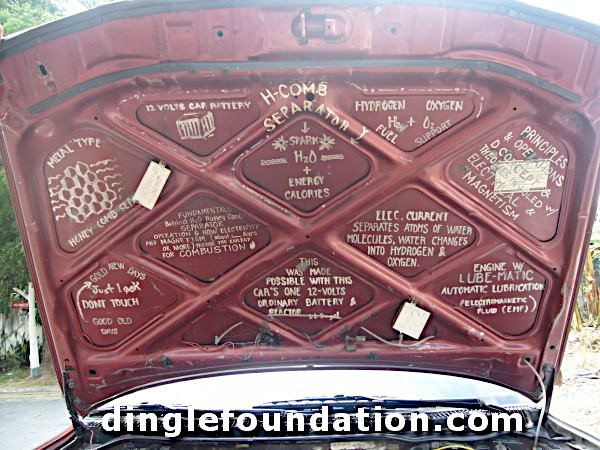updated 07-09-2023
Dingel’s Hydrogen Generator
Daniel Dingel has run his car on water for 30 years
Philippine inventor is said to have
converted 100 cars to run on water.
We have just learned that Daniel Dingle passed away recently
(and everything “disappeared”)
On 10/10/2012 12:34 PM, Peter Aldred wrote:
Daniel passed away in October 2010 at his home in the Philippines aged 84.
From what I heard, his son flew over from the States and everything then “disappeared”… when I was there he showed me a US Government white paper showing a 5 year recovery plan for the world economy if he were ever to release his technology… he was living on a private estate with security guards at the main entrance… I was told that he had been given $1 million to ‘continue his research’ and Bill Gate’s name was also mentioned but I don’t know how true that was where the million dollars came from.
So I presume the powers that be confiscated everything very quickly ‘in the interests of national security’.
All the best
Pete…Peter Aldred – CEO
The Ethos Group :: ethos.ag
“Ethos… New World Vision Technicians…”
“Dingle is known as a vocal critic of Filipino government officials and scientists who have refused to support his invention. The Philippines’ Department of Science and Technology, in turn, has since declared his invention a hoax.”
Dingle finally took a “buy-out”. see below
The Philippine Daily Inquirer reported that Daniel Dingel built a water-fueled automobile engine as early as 1969.
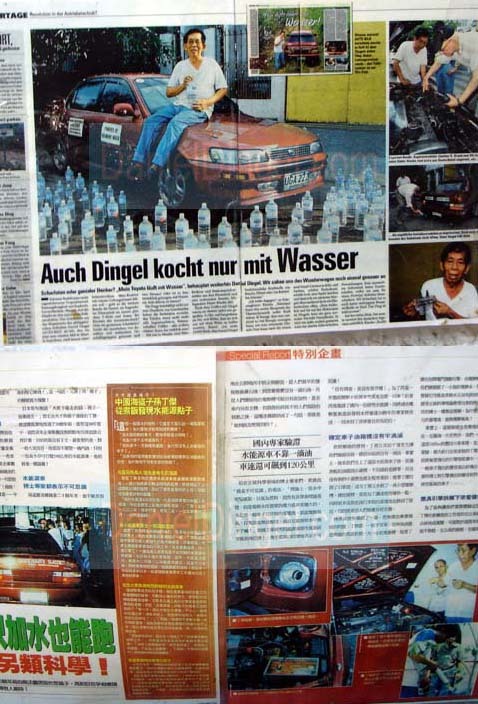
Dingel admits that his invention in its early years relied on around 30 cc (mL) of gasoline to start the engine and during idling, but he emphasized that those early prototypes switched to hydrogen once running. Today’s prototype is a dark red Toyota Corolla that no longer needs gasoline to start the engine.
Testing by reputable laboratories have been conducted as far back as the late nineties. In 1998, the Philippine Institute of Pure and Applied Chemistry (PIPAC) at the Ateneo de Manila Campus analyzed the gas output, revealing 45% Hydrogen composition. The year after, the TUV Rheinland Group through TUV Rheinland Taiwan Ltd. sent one of its engineers to describe the system.
Recently last May 2008, Mr. Dingel submitted his car for testing at the Philippine Department of Energy. The findings revealed that the hydrogen reactor produces a gas of 40.41% Hydrogen composition.
The Philippine Government almost started development back in the year 2000, as per a document for the signature of then President Joseph Estrada.
Dingel guested recently on Philippine government-owned tv station National Broadcasting Network (NBN), on the program Balitalakay (news discussion). He was also featured on Umagang Kay Ganda (tele-magazine show of TV network giant ABS-CBN) where he attributed the long delay in his invention’s development to rapid government policy changes and a lack of political will.
Another filipino has experimented and succeeded.
see our pageA Hydrogen Generator You Can Build
This Philippine man (Vox) mixed a little hydrogen in
with the gas as an experiment on his motorcycle.
See A Hydrogen Generator You Can Build
Biography
Daniel D. Dingel: His car runs on water, his life runs on ideas
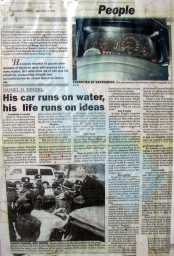
By FRED T. COMIN; People – The Manila Times; October 11, 1994
Committed to service
Daniel D. Dingel hails from La Union, his mother’s province, but lived in an orphanage, as his parents died when he was still young. Americans from Clark and Subic provided the lad opportunities for a predominantly technical education.
“I earned my mechanical engineering degree by dint of effort from the International Correspondence School. Perfected by practical experience” he says.
Dingel admits that he once nurtured the ambition to study for the priesthood but Providence willed otherwise, Still, he firmly decided to commit his God-given talent for invention to the service of humanity.
Skeptics
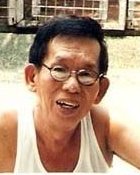
It was in the early 80s that Dingel came into the national limelight with his declaration that he had discovered a way to make a vehicle run on water.
This was in the wake of the first world oil crisis of the mid-70s which stunned everyone into realizing that petroleum was fast-dwindling natural resource and that western nations had to knock their noggins together to come up with alternative sources of fuel, fast.
Covered by international media Foreigners came flocking to grill Dingel about his invention, and a year or so later, one of them declared that the claim was hoax. But Dingel stuck to his guns and let Philippine authorities objectively evaluate his claim.
Test drives
In 1985, Dingel said, he drove his car from Metro Manila to Laguna over a distance of 167 kilometers(100 mi.) consuming 15 liters(4 gal) of water and half a liter of gasoline.
[see the youTube video, above, of another Philippino who rode 45 km on 1 liter of gasoline and a few ounces of water. {34oz/liter} – and read about Denny Klein who drove his car on only 1 oz. of water per 25 miles, with no gasoline at all.
Learn to build one yourself: “A Hydrogen Generator You Can Build” ]
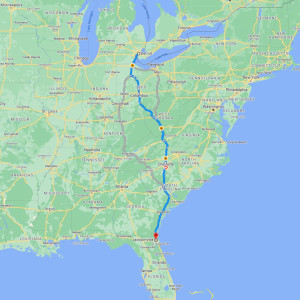
When he made a trip to the US, he added, he had occasion to show Americans that his car could make the Detroit-to-Florida run on 60 liters of water and two liters of gasoline. [1/2 gallon]
[Detroit, Michigan to Jacksonville, Florida is a little over 1000 miles (1007?) ]
Government authorities have confirmed these claims in scientific tests and today Dingel drives a car with these words, in bold letters, painted on the rear windshield: “This car runs on water.”
How it works
In brief, Dingel’s invention uses gasoline only to get the engine started. Then water passes through two reactors in the engine which splits it into hydrogen and oxygen to trigger off combustion.
More demos
Dingel is wary of securing a local patent for his water fuel invention, but papers for this are under process.
Although he would like to help our struggling country resolve its economic problems, Dingel hesitates to deal with government agencies. For instance, in one project costing a double-digit sum in millions of pesos he was told that he would clinch the deal if he were willing to come across with about 80 per cent of total project cost in kickbacks. That, he says, left a bad taste in his mouth. So he abandoned it.
Other dreams
Dingel too has dreams of his own. He has embodied those in an organizational chart of sorts in which future firms of his projected conglomerate – consisting of real estate, housing, solar energy generation, agribusiness, newspaper and magazine publishing ventures – would pool all their profits for the benefit of the poor in what he would like to call the Dingel Humanitarian Foundation.
Car of the Future
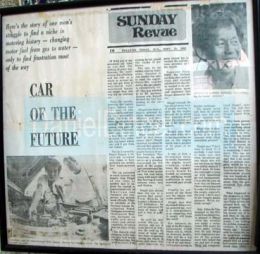
Sunday Revue – Bulletin Today; Sunday, September 29, 1985
DanielDingel.com Note: This is a text-encoded version of an original newspaper article as depicted in the photograph.
Here’s the story of one man’s struggle to find a niche in motoring history – changing motor fuel from gas to water – only to find frustration most of the way
IT WAS one of the smoothest car rides we ever had. The shifting of gears was flawless, the acceleration was effortless and the ride as a whole as normal as you can get from a well-tuned, well-maintained luxury car except that this was not an ordinary car.
From the outside, however, the Lancer Super Saloon was like any of the thousands turned out by the assembly plant. The body, the tires, the suspension system, the cooling system, even parts of the engine. The main difference, however, is that this car runs on water. Yes, ordinary, tap water which you and I get from our faucets.
The car is owned by Daniel Dingel, a 52-year-old inventor who claims to have perfected the world’s first water-powered car.
The car generated so much interest and inquiry that Dingel at one time or another had to explain the concept to representatives of American and Japanese car companies, top government officials, Filipino scientists at the National Science Development Board, Philippine Inventions Development Institute, mechanics, car buffs and many others and almost singularly, all agreed that the thing works.
The Bulletin chief mechanic, Rolly Salazar, also had doubts in the beginning. But when he observed the system, he too, joined the ranks of believers.
The car, by no means, runs on water alone. Gasoline is also needed but only to start the engine. Once the engine starts, the gas supply is automatically cut-off. This was attested to by BT mechanic Salazar who himself blocked the fuel line leading to the carburetor.
Dingel says that an engine powered by water becomes very efficient and more powerful. “A drop of water,” he says, “is equivalent to SS drops of gasoline.”
What about rust? Isn’t it that water causes rust? Dingel says that his research showed that gasoline shortens the life of an engine because of carbon formation. This formation, he adds, serves as a grinding compound on the parts of the engine and contaminates the oil. True water causes rust, but rust burns along with water and that burning of water reduces wear, tear and friction.
Dingel also claims that the car is a proven fuel saver. From Manila to Laguna, a distance of 147 kilometers, he said he consumed 15 liters of water and half a liter of gasoline.
He said he also tested the car in America and run it from Detroit to Florida. He used up 60 liters of water and two liters of gasoline during the travel. It was also there that some American experts viewed his invention. He said they were satisfied with the results.
Someone from BMW, the German car firm, also came to visit and though satisfied with the car, he wanted to be convinced some more and requested that Dingel dismantle the car.
Dingel refused. He has always been wary of people wanting to open up the engine because he is afraid that someone might steal the concept and use it for their own benefit.
Dingel says that the secret of his car is in the innovations he put in the engine which was a product of 14 years of research.
It was, at first, a hit-and-miss thing, he recalls. Sometimes the engine would overheat, other times, the compartments would be flooded, on occasions the spark-plug would malfunction or some important part would rust.
Finally he corrected all the flaws and the engine now works perfectly.
Dingle says that the benefit from a water-powered car, once it is mass-produced, is so staggering that it simply will bogle the mind.
For instance, he said, if the Philippine government would invest into it, which he, however, doubts, there will be a big drop in the consumption of oil and therefore a giant saving in foreign exchange.
The money saved will then be plowed back into the economy, creating more jobs and so forth and so on.
What then is stopping Dingel from producing it in a joint venture with other interested persons?
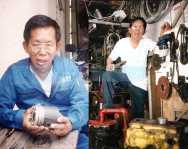 Dingel says “I don’t want to think ill of anybody. I just want to make sure that these inventions get into hands who will not use them for their own selfish motives. I didn’t work 14 years day and night to come up with something for rich businessmen. I was able to come up with this car because I have always wanted to make life better for the people, especially the poor. I don’t want to see hungry people anymore. We’ve suffered enough.”
Dingel says “I don’t want to think ill of anybody. I just want to make sure that these inventions get into hands who will not use them for their own selfish motives. I didn’t work 14 years day and night to come up with something for rich businessmen. I was able to come up with this car because I have always wanted to make life better for the people, especially the poor. I don’t want to see hungry people anymore. We’ve suffered enough.”
Atty. Eduardo Tan, assigned by the Filipinas Foundation Inc. as counsel to Dingel while the scientist was under a seven figure FFI grant for three years, reveals that he and Dingel have approached people in the government who tested the car and saw it work. They all congratulated Dingel, says Atty. Tan and that was the last time Dingel heard from them.
Why these government people haven’t done anything about the water-fueled car is a puzzle to Atty. Tan, who has tested the car on a 500-km. run from Makati to nearby provinces in the South. Why this is happeneing, I don’t know. Who can say what their motives are? But I do know that no private company would be in a position to manufacture the car here. The investment would run into hundreds of millions or billions of pesos. Only the government has that money.
What happened to the proposals of foreign investors? Dingel says flatly that he was not pleased with any of the proposals. “They all wanted to make big money out of it, just that, at the expense of the common people. I am looking for selfless, honest investors. I haven’t found any.” Dingel adds he wants the car to be priced within the reach of common people and no potential investor has considered that. (JDG)
Pinoy maker of water-powered car still fighting after 30 years
By Joey G. Alarilla; Motoring Section, Philippine Daily Inquirer
Thursday, August 12, 1999
The year 1969 was a landmark year for a number of reasons, including the conquest of space and cyberspace. Even as that year saw Neil Armstrong and Buzz Aldrin walking on the moon, so was the Internet born when its earliest incarnation, the United States Defense Department’s Arpanet (Advanced Research Project Agency network), went online.
In the Philippines, 1969 was also the year that a Filipino inventor claims to have started tinkering with a revolutionary concept for the automotive industry. His idea? To power cars using hydrogen derived from ordinary water.
Today, 1999 might well go down in Philippine history as the year that “prez freedom” – the freedom of the President to do whatever he damn well pleases – ran roughshod over press freedom. As the sight of “hit-and-run” victims like The Manila Times and the Inquirer shows, the Jeep ni Erap seems bent on turning into roadkill anyone brave or foolhardy enough to get in the way. And, 30 years later, inventor Daniel Dingel is driving around in the only water-powered car in the world, still complaining that Filipino government officials and scientists refuse to support his invention.
“They keep saying that the government is pro-poor, but what they do is sell off the resources and wealth of the Philippines. The government should really support the development of technology that would help the country pay its huge foreign debt,” he said.
At the Inquirer parking lot last Tuesday, Dingel showed off his “concept car”- a red 16-valve Toyota Corolla with the small hydrogen reactor that he invented hooked up to its internal combustion engine (ICE). Dingel’s hydrogen car has actually received media coverage since the late ’80s or so, but to date his invention has not yet been patented and commercialized. Dingel attributed this to the influence of multinational companies, notably the oil companies. A conspiracy theory worthy of the X-Files, perhaps, but if Dingel’s idea is real, then the truth is way out there.
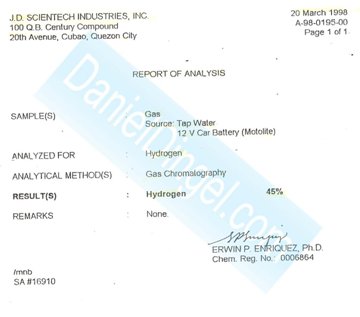
“The electricity from the battery splits the water into its hydrogen and oxygen components, and this hydrogen can then be used to power the car engine. Normally it takes temperatures of about 5,400 degrees Fahrenheit to generate hydrogen from water – and lots of electricity, but here I am just using an ordinary 12-volt battery,” he claimed.
Just how this kind of chemical reaction is possible using an ordinary car battery is, of course, the secret behind Dingel’s invention–and the kind of claim that leads people to dismiss him as a crackpot and charlatan. In fact, while hydrogen is being touted as a viable alternative fuel in the US and other countries, these prototypes do not make use of ICEs but fuel cell engines, nor do they run on ordinary water but on liquid hydrogen.
For example, last March 17 Daimler-Chrysler unveiled in the US the hydrogen-powered Necar 4 (New Electric Car), which is based on a Mercedes-Benz A-class compact car. In these fuel cell cars, water is just a by-product of the reaction between hydrogen and oxygen ions, which produces the electricity to run the car’s engine. In this sense, the fuel cell process is the reverse of Dingel’s discovery. Also, Dingel claims that his reactor can work with any existing ICE-based car.
According to Dingel, some investors from Taiwan now plan to commercialize his car and help him get an international patent. [It is this which got him in trouble with the courts and a prison sentence in 2008]
In the Philippines, Dingel also partners with Cobis Clean Cars for another invention that his hydrogen car showcases – the so-called electromagnetic fluid (EMF) treatment.
This treatment is supposed to improve a car engine’s performance and oil life because it produces an “air magnet” to reduce friction to practically zero. Sounds like something the Jeep ni Erap could use to reduce friction with the media. Moreover, since, as Inquirer contributor Vernon Sarne pointed out, the Jeep ni Erap is alcohol-fed, EMF would make the jeep even more environment-friendly by reducing the emission of noxious fumes.
So, is this Pinoy hydrogen car for real, and will this idea soon drive the cars we’re driving? That’s the dream that Dingel has kept alive for 30 years.
Philippine Daily Inquirer
First Posted 03:11:00 12/20/2008
Filed Under: Crime, Automotive Equipment
MANILA, Philippines-Daniel Dingel, 82-year-old inventor of a “water-powered car,” has been convicted of “estafa” [swindling] and sentenced to a maximum of 20 years imprisonment by the Paranaque City Regional Trial Court.
Daniel Dingel Water Powered Car Inventor gets 20 years for ‘swindling’
Posted by keelynet on December 20, 2008
The technology is NOT invalidated by this court action.
“Daniel Dingel, 82-year-old inventor of a “water-powered car,” has been convicted of “estafa” [swindling] and sentenced to a maximum of 20 years imprisonment by the Paranaque City Regional Trial Court. The court also ordered him to pay $380,000 in actual damages. Dingel, who has never revealed the secret to his invention, which he began in 1969, questioned the verdict but said he did not mind going to jail at his age. As of late Friday, he remained at large. Dingel was found guilty of taking $410,000 from Dr. John Ding Young of Formosa Plastics Group, a Taiwanese company, which gave it to him as research and development funds. The decision, written by Judge Rolando How of the court’s Branch 257 and released on Dec. 9, said Dingel defrauded Young when the inventor failed to fulfill his obligation of developing his “hydrogen reactor” and creating experimental cars in 2000. The unique device – a “hydrogen reactor” resembling a 12-volt battery – impressed the Taiwanese when Dingel demonstrated how it powered and fueled the car’s engine. They were also told that fuel from water had clean emissions as it did not produce carbon the way gasoline did. After receiving the money ($300,000) by wire transfer, Dingel avoided replying to his emails on the progress of the project and instead sent copies of letters from other foreign investors offering Dingel larger sums of money. Young said he kept his end of the bargain by sending another $60,000 in additional funds for R&D as stated in the joint venture agreement. He said it was then that Dingel began ignoring his communications. He said he sent demand letters for the return of $410,000 were but Dingel did not give the amount back. Instead of returning the money, Dingel withdrew $375,603.89 from his bank account and left only $500. “He admitted withdrawing the money after learning that a suit had been filed against him,” it said. “His act of immediately withdrawing the money indicated bad faith on his part.” – Source
******************************************
Paranaque,
MEETING DANIEL DINGEL, WATER-POWERED CAR INVENTOR
Jul 5, ’08 11:08 AM
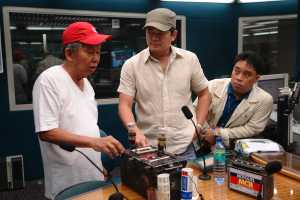
I finally got to meet and interview Daniel Dingel in our radio program Magandang Morning with Julius & Tin-Tin on DZMM.
Dingel’s critics from the Department of Science and Technology have branded him as a “loony” and dismissed his invention as a hoax. But I must say the guy made a lot of sense.
He claims he invented the water-powered car which could possibly help solve the world’s worsening oil crisis. It’s better than the electric-powered car that the U.S. has developed because Dingel’s car only uses water to fire up a vehicle, unlike an electric car which runs on hydrogen that still depends on electricity.
Dingel believes that the reason why government refuses to recognize his invention is because many government officials actually hold interests in the oil industry.
Dingel told me that he presented this invention to a number of Presidents but only Erap expressed interest. 2 days before he was ousted as President, Erap was prepared to sign a memorandum that would recognize Dingel’s technology to the benefit of our consumers.
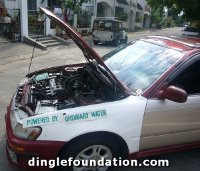
Dingel is 80-something already. He might not see the day when his invention is finally recognized by any government. Up to now, he says he is not interested in selling his technology to foreigners because he wants Filipinos to benefit from it first.
Let us do away with egos and ambitions and open our eyes, minds and hearts in finding solutions to this worsening problem.
see many YouTube videos on Daniel Dingel
After years of trying to control his invention, to make money from it,
Mr. Dingel was “bought off”
Perhaps all the doubters and detractors finally “got to him” and he sold out.
09-14-2012 – 12:15am
He was given $1 million
“[and allowed] to ‘continue his research’ but to then just take people out for rides in his water-powered car; but not to tell anyone how it actually worked… And I promised him that I wouldn’t release this information until after he had passed on and left this world.
“Thousands of people, from all over the world, trying to discover his secret visited him almost daily… If you look closely at the picture above, he had written the instructions on how it works under the bonnet [hood]:
H2+O+[12V+HONEYCOMB SEPARATOR+H2O+SPARK] = ENERGY CALORIES
The HONEYCOMB-SEPARATOR is the key
When you look in the top of the unit you can see the honeycomb grid, about 2/3 of the way down inside the unit, sat horizontally above the core below.
the NEODYMIUM MAGNETS + BISMUTH make up the core…
They thought (hoped) that he’d taken his secrets to the grave with him…Another very big clue is that it also generates electricity … You put 12v of electricity into the unit and it disassociates the water molecules and gives out the HHO gas… but, if you disconnect it from the car battery, it then gives out electricity… so it’s a two way reactor.
Daniel told me that by connecting one of these units to an inverter, to step up the output voltage, and simply filling it up with water, it would then power a small fridge or TV for several months, he said approximately three to four months… He didn’t say, but I presume that after that time you just had to fill it up with some more water again…
With the unit out of the car and sat on the ground with water in it he had an electric car lamp (12v) and when he connected it to the unit and put one connection on a probe and put it inside and touched it on the main flat honeycomb mesh inside of the unit the lamp lit.
And the unit was definitely running on pure tap water as he filled it from the mains water supply, and I even put my finger in and tasted it, just to make 100% sure… and it was ordinary pure tap water with no electrolyte.
He did also say that if fresh water isn’t readily available it will work just as well with sea water… and that the car would drive at 70km/h for approximately 1 hour, on 1 litre of tap water… He also told me that so far he had converted over 100 cars there to run on water since he first invented it.
He also used his EMF Oil treatment which is a plant-derived synthetic oil additive which reduces the coefficient of friction to almost zero in any mechanical device which is lubricated with oil. No air filter and he had slightly modified the air intake to let more air in past the throttle valve and to incorporate the HHO gas feed pipe.
The timing needs to be set to after TDC instead of before TDC i.e. if it’s normally 8 degrees before TDC start somewhere around 8 degrees after TDC… and you also need to work out a way to eliminate the waste spark if your engine has one, i.e. if it sparks on the exhaust cycle as well as the compression cycle and most 4-stroke petrol engines do. The waste spark doesn’t matter on petrol engines… but with HHO it’s a completely different kettle of fish.
Also, as HHO gas burns much hotter you need hardened valve seats or you’ll soon burn them out running on pure HHO gas. LPG engines should be a lot easier to work with and convert as they should have hardened valve seats in them already.
He also explained to me that most of the extra gadgets fitted under the bonnet were simply red-herrings to throw people off the scent and confuse them; like the three large solenoids at near the front of the engine – they were just fitted there for show and didn’t actually do anything.
All the best,
Ethos Petefor more information, See
Dinglefoundation.com/hhoblog/
www.hhoforums.com/showthread.php?t=7293
Today
For simple instructions on how to run your car run on hydrogen see our page
Build Your Own Hydrogen Generator
– or –
Run Your Car On Vapors-Fumes
The Francisco Pacheco Hydrogen Generator
Dennis Klein’s Gas Engine Water additive
Stanley Meyer’s water powered car






